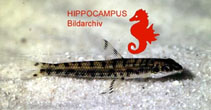| Family: |
Distichodontidae (Distichodus) |
| Max. size: |
6.1 cm SL (male/unsexed) |
| Environment: |
demersal; freshwater, |
| Distribution: |
Africa: Lower Guinea endemic, only known from the Sanaga River basin, Cameroon (Ref. 26632, 81638). |
| Diagnosis: |
Dorsal spines (total): 0-0; Dorsal soft rays (total): 12-14; Anal spines: 0-0; Anal soft rays: 9-10; Vertebrae: 37-37. Diagnosis: 50-53 (Ref. 81638) or 46 (Ref. 26632) scales in lateral line. 6-7 anal fin branched rays; dorsal portions of body with distinct dark, vertically oriented dark marks that form saddle-shaped pigmentation pattern; prominent horizontally elongate, dark spots on mid-lateral surface of body (Ref. 81638).
Description: body moderately elongate, depth 0.19-0.23 SL and slightly laterally compressed; mouth relatively small and slightly subterminal; both jaws with 1 row of bicuspid teeth; premaxilla with 4 and dentary with 4-6 teeth; maxilla edentulous; distal portions of lateral pelvic rays enlarged in some specimens; middle pelvic rays longest and reaching beyond vent about one third of distance between vent and anal fin origin; larger specimens (mature males?) with basally directed retrose hooks on dorsal surface of first through 6th to 8th branched rays; all scales ctenoid in immatures and females of moderate size; some individuals (mature males?) with numerous fleshy ‘contact organs’ distributed over head, body and margin of rays; scales medial to pectoral fin lack posterior ctenii, but have lateral surfaces of scales completely covered with anteriorly directed hooks; lateral line irregularly pored in smaller individuals, but complete in larger specimens; 4-5 scales between anal fin origin and lateral line; D: III,10-11; A: III,6-7 (Ref. 81638). 9-11 dorsal-fin branched rays (Ref. 26632). 5 (Ref. 81638) or 5.5 (Ref. 26632) scales between lateral line and dorsal-fin origin.
Coloration: preserved specimens yellowish tan, darker dorsally; dorsal portion of head and ventrolateral portion of opercle darker; dorsal and dorsolateral portions of body with 7-9 saddle-shaped marks continuous with irregular mid-lateral band formed of 5-6 horizontally elongated spots; ventral portion of body with series of irregularly vertical, dark bars aligned in some cases with dorsal saddles (Ref. 81638). More details on fin coloration can be found in Ref. 81638. |
| Biology: |
Found under rocks, in riffles of moderately large rivers (30-50m) in the savannah zone, in areas where there is a strong current (>1m/sec); in all sites where collection took place, there was a rather restricted gallery of shrubs and small trees on the river banks; water was greenish with a transparency of about 50 cm, neutral pH (6.5-7.5), with a high content of dissolved oxygen (6.5-7.5 mg/l) and a rather low conductivity (35-45 µS/cm); water temperatures were between 23 and 25 °C at noon (Ref. 26632). |
| IUCN Red List Status: |
Vulnerable (VU); Date assessed: 16 February 2009 (B2ab(iii)) Ref. (130435)
|
| Threat to humans: |
harmless |
Source and more info: www.fishbase.org. For personal, classroom, and other internal use only. Not for publication.

